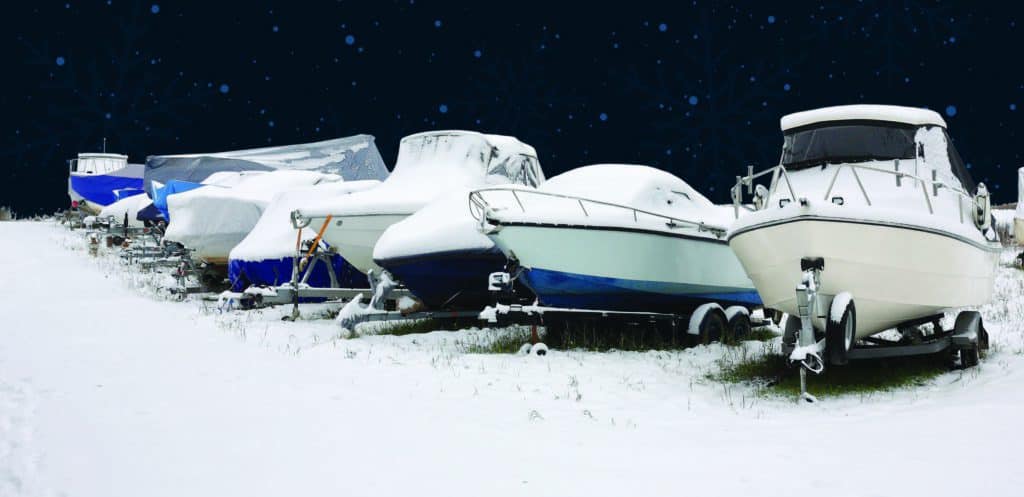In nautical lore, the traditional method of winterizing a boat involved a compass, a bar of chocolate, an anchor, and a bottle of rum. At the end of the boating season, you set the chocolate on the deck, use the compass to head south, and when the chocolate starts to melt, you drop the anchor, open the bottle of rum, and wait for spring.
If you’d rather not waste the chocolate, Steve Zimmerman of Zimmerman Marine has some alternate advice.
“We look at winterizing from three different levels,” he explains. The basic level is to just make sure nothing freezes over the winter. “That’s just a matter of addressing the engine’s cooling system, the generator, and the boat’s plumbing system.
“But if you want to go a level above that, there are certainly things I would recommend, like a formal fall sea trial before you put the boat away. That should tell you if the alternator is keeping the battery at the proper voltage, if it’s cruising speed is at the proper RPMs, and if there’s any vibration at open throttle.”
These red flags could indicate work that needs to be done and you might as well have it done over the winter. “If you do that,” Steve explains, “it’s less likely that you’ll get a call from us in the spring when we go to launch your boat for the season. You’d like to have known that before you put the boat away in the winter.”
There’s a little bit of controversy about whether to do an oil change in the fall or in the spring, “but it’s better to do it in the fall if you can,” he advises. “That’s better than leaving dirty oil in the engine all winter long. But we change the impellers in the water pump in the spring because we don’t want the new impellers to sit in one position all winter long.”
Before you change the oil in the fall, Steve advises that you have a sample tested to see if there are any trace metals that might indicate engine wear. “Let’s say there’s a trace metal that indicates the rings are wearing,” he explains. “You’ll know you need some work done, and at least you won’t have the engine break down while you’re out cruising. You can buy the kit and do it yourself, but it’s better to have your mechanic do it. They send it out to the lab and you get a written report.”
If you haul your boat and store it on the hard, you need to be sure to keep all of the cockpit drains open, he warns. “We’ve had boats sink on dry land, when the rainwater fills the cockpit and drowns the engine.”
October and November can be two of the nicest months of the year for boating on the Chesapeake Bay, but don’t wait to schedule whatever it is you want to have done, Steve cautions. “If you’re going to have the yard do it, you should call and schedule now.”
Zimmerman’s six locations include Deltaville, Mathews, Va., and Herrington Harbour in Tracy’s Landing, south of Annapolis, and accommodate all these services.
Andy Fegley is an American Boat and Yacht Council Certified Marine Electrical Technician who’s owned Yacht Electronics Systems in Annapolis since 1990. He specializes in electrical systems, including alternative energy management solutions for long-range cruising boats, both sail and power.
The number one problem with winterizing, Andy declares with fervor, is “defective batteries. People don’t make a plan to keep them charged over the winter.”
Andy advises that you let your batteries sit for a month and see if they’re falling below 12 volts. “If they are, you are doing damage to them,” he says. You should periodically charge them, at least every two months. Or you can set up a trickle charger. “If you’re shrink-wrapping your boat, you want to leave the main breaker on along with the individual breaker for the shore power, then leave the shore power cord dangling outside of the shrink wrap.”
In Andy’s judgement, half the boats out there suffer from “parasitic power drain.” Electronic equipment like the amp-hour monitor can use up battery power even when they’re not on. “Way worse are things like carbon monoxide and smoke detectors,” Andy warns. “If they’re 12 volts, they’ll run a battery down in six weeks.”
“The winter is a good time to take care of any kind of equipment that’s getting older,” says Marshal Larner, owner of J Gordon & Co in Annapolis’s Eastport neighborhood. “That’s when we’re not so pressed to get from one boat to the next,” like they are in the spring. “A lot of people have problems and limp along until the end of the season.”
Larner has an ABYC-certified electrician on the staff of his full-service yard. Other qualified tradesmen can address plumbing, climate control, refrigeration, carpentry, navigation and communication systems. They can also completely refurbish your current boat inside and out.
Winter is an excellent time to schedule an upgrade on the heating and air conditioning system. “Almost all the air conditioning units are reverse cycle, so they can heat and cool as well.” Marshal explains. “That way, people can use their boats several more weeks or months on each end of the season.”
Marshal also recommends VacuFlush toilets as a retrofit upgrade. VacuFlush systems operate with your existing fresh water and uses only about a pint per flush, much less than other systems. Less water during the flush cycle in a VacuFlush system allows for up to four times more holding tank capacity than other types of systems.
“Those are the two things on a boat that will keep a spouse away: no working head and no air conditioning,” Marshal notes. “Both are good choices for upgrading.”
Whether you own a center console or an ocean-going yacht, another good investment would be to install a gyro stabilizing system like Seakeeper, based in California, southern Maryland.
“Seakeeper can eliminate 90 percent of all roll in any boat from 23 feet on up,” Communications Manager Kelsey Barrett explains, making it a good choice for “anybody who’s prone to sea sickness or needs a solid deck for fishing, or who has mobility issues. It works at rest or underway, and it’s all internal so there are no external appendages. We install it and you have a stable ride all day out on the water.”
The smaller units can be deck-mounted, so they can be tucked beneath the existing leaning post or inside a center console, she says. “The good thing is that it doesn’t have to be on the centerline, especially on larger boats, but we do prefer that it’s installed midship-aft.” All of the Seekeeper dealers are independent, so it’s good to shop around when you’re pricing out installation.
As for sailboats, one sailmaker says it’s best to “pull the sails at the end of the year.” Jerry Latell is from Latell Sailmakers in Deltaville, which recently joined the Evolution Sails Group. Latell’s loft has served sailors for more than 30 years. “Get them out of the elements,” Latell says. “It’s a good exercise anyway—you’re looking at the sails, the rigging, the gear” to see if there’s any wear and tear that needs to be addressed. It’s good to get them back to the loft at least every other season for professional inspection and cleaning.
“The big stuff anybody can spot, but we can see sun damage the customer can’t see. We know the parts that wear first,” he notes. The leaches tend to wear out, he says, but the biggest problem is the sun. “We can see stitching that’s about to go. It’s much easier to repair the earlier you catch it.”
Stack type mainsail handling systems have become quite popular for good reason, Jerry explains. “These systems allow you to integrate a mainsail cover with lazy jacks which greatly reduces the hassles of raising, lowering and stowing a conventional mainsail.”
Latell also offers sail modification and sail wash services, in addition to a full canvas department offering repairs as well as new Biminis, dodgers, and enclosures.
Just like the sails, the canvas and enclosures should be taken off the boat in the winter, according to Rob Pennington, who owns the Cover Loft in Eastport with his partner Sean Lawlor. “The primary thing that everybody should do with canvas is to get it off the boat and don’t leave it on the boat over the winter,” Rob advises. “The wind buffeting the boat will wreck it. Don’t use it as part of your winter enclosure.”
It’s important to clean it every year, he says. “Bring it in for check-over and repair. We make sure the zippers are in good shape, that the stitches are secure. We have a wash service to get rid of mildew. We clean and polish the glass, things like that. People just ball up their canvas over the winter and expect it to be perfect in the spring. It’s a pretty costly item, so you have to take good care of it.
“This time of year, people start bringing their canvas in and it’s old and rotten,” Rob notes. “It needs to be replaced after 10 years or so. You don’t have to start from scratch, because most people have frames that are decent. But you do need to get new patterns. You can’t use the old canvas for patterns. You can use it for basic measurements, but not patterns. So it’s important to get started early. These are pretty involved projects when you’re replacing Biminis, dodgers, or enclosures. It’s important to get a good pattern before you put the boat away. Definitely before you shrink wrap it.”
Most boats are chronically under-maintained, laments Andy Fegley of Y.E.S. Electronics. “People only call when their boats aren’t working right. People have to take responsibility for their boats. I get 20 calls on the first nice day in spring. I get calls every Monday from people who found things wrong with their boats over the weekend.” So be proactive with maintenance on all of your systems and protect the investment you have made in your boat. Call your yard now, or your discontent will come next spring, when you want to enjoy your boat out on the Bay.




